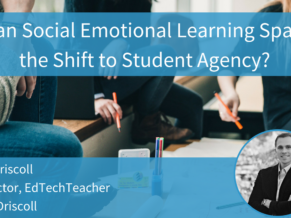More than any other idea in education, the idea of student agency suffers from the greatest disconnect between intentions and outcomes.
As I referenced in a recent post, emerging student-centered instructional models attempt to shift much of the ownership and control (agency) of the learning process over to students. Whether it is an approach that customizes the student’s path and pace through the curriculum, or is an inquiry-based environment that has students engage in a problem solving/design thinking approach, students have greater degrees of agency in new models of student learning.
Yet this seems to be extraordinarily elusive when it comes to classroom practice. I myself experienced this as a teacher who experimented with 20% Time in my high school courses, albeit with mixed results. In my current role at the district level, I see teachers in various contexts struggle to make this shift towards student agency as well. Of course we can point to certain classrooms or specific schools across the nation who do this effectively, but it has certainly not been implemented at scale the way other concepts have. Why is this so difficult? What are we not getting it right?
I recently started to think that I am not asking the right questions. What if instead of asking about what the teacher is doing from an instructional design standpoint, I focus instead on the student experience. Most of the feedback I hear from teachers (and experienced as a teacher myself) is that students cannot “handle” that much control. But we need to unpack that assumption a bit. I understand what the teacher means by this, but what specifically do students need to know, think, and believe that would enable them to actually “handle it”?
In other words, what skills, attitudes and behaviors best equip students to thrive in environments that require student agency over their learning?
Image Source: https://casel.org/what-is-sel/
When preparing for Bristol Warren Regional School District’s recent Admin Retreat, I spent considerable time diving into social emotional learning (SEL). As a district, we are working off of CASEL’s model that defines SEL as “the process through which children and adults acquire and effectively apply the knowledge, attitudes, and skills necessary to understand and manage emotions, set and achieve positive goals, feel and show empathy for others, establish and maintain positive relationships, and make responsible decisions.” I quickly realized that this may be THE missing piece. Could SEL be the key to unlocking students’ ability to “handle” student-centered environments? What if we focus more on strong SEL environments first before diving right into student agency? Will this enable students to engage in student-centered learning? Would the success of students then spark a revolution in student agency as teachers see students who once struggled in these contexts begin to thrive?
If this is the case, we should shift some of our focus towards the knowledge and skills promoted by SEL, such as self-awareness, self-management, and relationship skills, that students can then tap into when engaged in student-centered environments.


